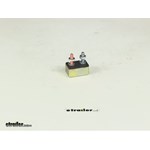Single Pole 20 Amp Thermal Circuit Breaker - No Mounting Bracket

- All Info
- Reviews (5)
- Q & A (0)
- Videos (2)
- Photos
Pollak Accessories and Parts - PK54-120
- Wiring
- Circuit Breaker
- Pollak
- 20 Amp
- Single Pole Thermal Type Circuit Breaker
- 20 Amp DC
- Voltage rating: 12 VDC
- No Mounting Bracket
- Cycling Automatic Reset
- Complies with SAE Standard J553
54-120P Single Pole 20 Amp Thermal Circuit Breaker - No Mounting Bracket


Videos are provided as a guide only. Refer to manufacturer installation instructions and specs for complete information.
Video Transcript for Pollak 50 Amp Metal Circuit Breaker Review
Hey everybody, Ryan here at "etrailer". Today, we're gonna be taking a look at and showing you how to install the line of pollak type one circuit breakers. A circuit breaker is a really small but important component. Like the one that we have here today. And what that circuit breaker is gonna do is protect whatever you're powering up. Whether it be a fan, a winch, a pump, a motor.
In our case today, we have this for a trolling motor on a fishing boat. It's going to protect those accessories. That way if a short or something like that we're to happen, they're not going to destroy that accessory. So the way the circuit breaker is going to work is almost like a fuse. To kind of keep things simple.
There's actually a contact inside of the breaker that allows power from one side of the breaker to the other. Well, whenever electricity is running through that contact, it's going to generate heat. And depending on what size breaker you have, whenever it detects too much of that heat, it's going to lift that contact up or break the connection if you will. That way, power can no longer go from your battery or your power source to the auxiliary product that you're powering up. So you no longer gonna have that connection.
And that's going to protect that said accessory. Now these are auto resetting. So what that means is once that contact cools down enough, it's going to make the connection again. And power will once again flow through. These breakers are designed to work with 12 volt systems.
However, if your accessory runs on a different voltage, lets just say 24 volt to give an example, you will need to get a different type of breaker. And I would just suggest one like this. This is a type three breaker. You could see they're a little bit different but the concept is the same. They're gonna work the same and keep everything protected. And because this is a type three, it's going to allow you to use up to 42 volts. So something I thought that was worth mentioning and if that's your case, you can find these breakers right here in etrailer. So there's a few different reasons why you would need a circuit breaker. One of them being, let's say you're hooking up a new accessory and you wanna make sure to keep it protected. So that's pretty straightforward there. Another reason would be sooner or later, even though these breakers are auto resetting, if they do trip a lot, sooner or later they will wear out and just not work anymore. So you could always just use it as a replacement. Or like in our case today, this is a new boat and this was the existing breaker on that trolling motor. And when you tried to remove the wires, the studs are just completely rusted. The stud actually broke off in there. You can't get the nut off of it. And personally, when it comes to stuff like this, I just wanna make sure that the electrical system is right. And I don't want any trouble. Be stranded out in the water or anything like that. So that's why we replaced this one. It's just worn out. And by doing that, it gives you a little more peace of mind knowing that you have a brand new breaker and you have something that's reliable. Just something I wanted to point out, in our case, our breaker is mounted in this compartment here, where it's gonna remain dry and out of the elements. But if yours is mounted outside, that's just fine. The weather isn't going to damage it. Obviously after years of use and everything else will start to show somewhere. So one thing you can do, you can pick up separately a rubber cover that kind of goes over this breaker and over the contacts. So it's gonna help keep everything off of it and not to mention too, might eliminate you if it's somewhere in a high traffic area or something, for example. And you're worried about bumping into the two breakers while you have power to it or the two studs rather. It'll eliminate you from tripping the breaker that way as well. So just something I thought was worth mentioning. So now that we seen our breaker mounted up and kind of learned about how it works and what it does, let's go ahead and set a few different ones on our bench and take a closer look at them. So when it comes to the line of pollak circuit breakers, you're gonna have many different options. So here, I just laid out a few of the common ones. We have a 20 amp, a 30 amp, and a 50 amp. And as you can see they're nearly identical in size, shape, everything else. The only difference is going to be internally. So just to kind of give you a comparison there. Now there's a lot of different combinations that you could use. Here, we have our mounting bracket that runs this way. But these are also available with mounting brackets that run the opposite way. So it can have a couple of different mounting choices. Whichever best suits your needs. And there's also these breakers without any brackets at all. So if you have maybe some type of housing or something that your breakers we're originally in, there's an option available for you as well. Something I do like about these breakers is that the studs are going to be different colors. And they're also going to have a label, auxiliary and battery. So it really does take the guesswork out of it whenever you're hooking this up. You know that the copper-colored post labeled battery is gonna go to your source of power and the silver-colored one labeled auxiliary is going to go to what you have it hooked up. Whether it be a pump, a motor, winch, whatever the case may be. So it really just makes things a little bit easier. So sometimes these things have to be mounted in relatively tight spots. So I figured there's a couple of measurements that some of you may find useful. If we go from the center of the hole to the center of the hole here in the mounting bracket, that's going to measure out one and nine-sixteenth of an inch. And that measurement is gonna be the same regardless if you have the mounting bracket like this or the straight mount one. As far as the height. So from the bottom of the breaker to the top of the stud, that's going to be one and three-eighths of an inch. So relatively compact. And as long as you have a little bit of space, you should be able to get these mounted up properly. So when it comes to actually figuring out what size breaker you need as far as the amperage rating goes, there's a few different things that you can do. A lot of times, whatever product you're trying to power up will actually have a label on it telling you what size breaker that they recommend or how many amps it draws. If that information is not on there, you can always reach out to the manufacturer. And nine times out of 10, they're going to have a suggestion that they would give you. Or if all else fails, you can always use an amp meter and measure the amount of amps that product is drawing. And that can help you figure out what size breaker you need. If you ended up testing it, kind of a good rule of thumb is just to get a breaker rated a little bit higher than what it actually pulls. Not by much. And I say that because a lot of times these products, when you first turn them on, they can draw a little bit more amps right off the bat. And so you want to give that a little bit of room. You don't want to trip your breaker all the time for no reason really. So as far as choosing what size breaker you need, that's just a little bit of information you can use to help figure that out. I will say the breaker does feel pretty good. Like it's well-made. It is metal here on the housing and there's some plastic up top. But even if you try to squeeze it really hard and try to bend it or flex it, it's not moving at all. So it's nice and solid. Feel like if you bump into it or anything like that, shouldn't really have to worry you a whole lot. And I do like the fact too that they give you nuts that are actually really star washers, almost. It's like a lock nut. So that way, whenever you hook up your wiring to it and snug it down, you shouldn't have to worry too much about that backing off over time or becoming loose. But other than that, regardless of your application, these are all gonna get installed pretty much the exact same way. And it doesn't really take a whole lot of time. Not a whole lot to them. So really shouldn't give you a whole lot of issues. Speaking of which, let's go ahead and hook it up together now. So to get your breaker installed, the first thing that you're going to want to do is make sure that you have your battery or power source disconnected. So in our case, we have a battery disconnect switch here. So I'm just going to turn that into the off position. Now we won't have any power. And what I'm going to be powering up or using the circuit breaker for rather, is a trolling motor on a fishing boat. And like I said, these have tons of different applications. And this is just one of them. So here's my wires. And what I'm gonna do is take the breaker and I'm going to mount it to this wall right here. Now, whenever you mount this up, keep in mind that the copper-colored post labeled battery, goes to the power supply and the silver auxiliary post goes to whatever you're running. So mount it to what makes sense. In our case, this is my battery wire, the one that is getting power. So I'm gonna mount this with the battery post facing up. And I'm going to use some self-tapping screws to do that. And you can find these here at etrailer. If you need some. Get it lined up. What I like to do, get one going about half way. That kind of allows you to swing it where you want it to go. My grandma always self tapper. You got a whole lot of room to work with here. Get that in. Then we can just run them both down completely. So now that we have the breaker secured we can go ahead and remove these nuts. Now, when you're taking these off, be careful. A lot of times they kind of just pop right off at the end. And they're pretty easy to lose. So just be mindful of that. So once we have them off, we can take our corresponding wires. So again, this one here is coming from my power supply So I'ma put that ring terminal over the battery stud. And I do wanna mention, if you need any ring terminals or anything like that, you can pick those up right here at etrailer. We have quite a bit of wiring options and different types of ring terminals. So if you're running low on any of that stuff, you can always grab it here. And then I'm gonna take my other ring terminal. This goes up to the trolling motor itself. So I'll put that over the auxiliary post. Let's go ahead and get these started hand tight. We can come back with a three-eighths socket and just tighten tighten the nuts down. Whenever you're tightening these, you don't have to really crank on them by any means. You just want to get them snug. Then I usually go kind of more, maybe another eighth of a turn. Something like that. So once you get everything on tight. So once you have everything tight and you're done working on all your electrical components, we can go ahead turn our power supply back on. And it's not a bad idea just to test our component to make sure that everything's working properly. To test it, you're just gonna turn it on and make sure that it works properly. And you can see, we have power to the motor. Our propeller is spinning and I think we're good to go. And that'll finish up our look at and our installation of the line of pollak type one circuit breakers..
Customer Reviews
Single Pole 20 Amp Thermal Circuit Breaker - No Mounting Bracket - PK54-120
Average Customer Rating: 4.8 out of 5 stars (5 Customer Reviews)
It’s a circuit breaker and it works. I don’t know what else to say except it is not ignition protection rated so keep in mind if you are in a combustible gas environment.

Good
A quick and simple replacement to an aging breaker. Works great.
Great are mystandby parts
See what our Experts say about this Pollak Accessories and Parts
- Is the Bus Bar the Common Power Point on the Pollak 7-Circuit-Breaker Junction BoxOn the Pollak 7-Circuit-Breaker Junction Box, # PK52249, the bar inside is just a mounting bracket for circuit breakers. You would connect power as needed to each circuit breaker. The bar was also designed to dissipate excess heat generated from the items attached to the circuit breakers in the box. The box accepts studded circuit breakers like # PK54-120, # PK54-130, and # PK54-140.
view full answer... - How To Test An Automatic Reset DC Circuit Breaker To test if the circuit breaker # PK54-120 is functioning you would just set your multimeter # PT89ZR to DC and test that you're getting power on both terminals. If you're getting no volts or less than 12 volts then you'll need to replace it.
view full answer... - What Trips and Reconnects the # PK54-120 Circuit BreakerThe circuit breaker part # PK54-120 trips when it gets too hot and then once it cools back down to a normal range the connection is reestablished.
view full answer... - Which Circuit Breaker to Use When Installing Prodigy P2 Brake ControllerHey Gene, so the amperage requirement of the breaker that you'll use when installing your Prodigy P2 brake controller part # 90885 will be based on the amount of brake axles your trailer has but generally a 30 amp breaker is fine. For a single axle a 20 amp breaker like part # PK54-120. For a double axle the 30 amp breaker part # 7012A.
view full answer... - What Circuit Breakers Are Compatible With Pollak 7-Circuit Breaker Junction Box? You will need to verify the power draw required for the particular circuit you are adding a circuit breaker. Then you be able to select either a 20-Amp # PK54-120, 30-Amp # PK54-130 or 40-Amp # PK54-140 circuit breaker to install in the Junction Box # PK52249.
view full answer... - Instructions for Circuit Breaker Installation in the Pollak 7-Circuit-Breaker Junction Box # PK52249I spoke with my contact at Pollak and found that the Pollak 7-Circuit-Breaker Junction Box, item # PK52249, has a metal bar in the bottom of the junction box that is designed to accept metal base circuit breakers that do not have a mounting bracket attached to the bottom. These circuit breakers have recesses in the bottom that accept the studs sticking up from the metal bar in the junction box. There are no directions available for the junction box. Our part numbers for the appropriate...
view full answer...
Do you have a question about this Accessories and Part?
Info for this part was:





At etrailer.com we provide the best information available about the products we sell. We take the quality of our information seriously so that you can get the right part the first time. Let us know if anything is missing or if you have any questions.
















































Thank you! Your comment has been submitted successfully. You should be able to view your question/comment here within a few days.
Error submitting comment. Please try again momentarily.